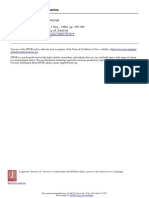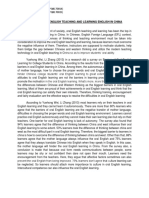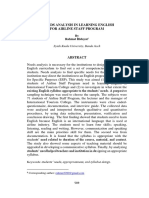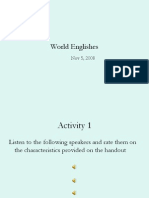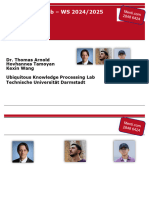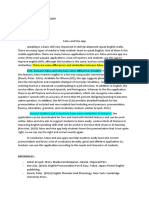Teachers of English To Speakers of Other Languages, Inc. (TESOL)
Teachers of English To Speakers of Other Languages, Inc. (TESOL)
Uploaded by
GermanCopyright:
Available Formats
Teachers of English To Speakers of Other Languages, Inc. (TESOL)
Teachers of English To Speakers of Other Languages, Inc. (TESOL)
Uploaded by
GermanOriginal Description:
Original Title
Copyright
Available Formats
Share this document
Did you find this document useful?
Is this content inappropriate?
Copyright:
Available Formats
Teachers of English To Speakers of Other Languages, Inc. (TESOL)
Teachers of English To Speakers of Other Languages, Inc. (TESOL)
Uploaded by
GermanCopyright:
Available Formats
Teachers of English to Speakers of Other Languages, Inc.
(TESOL)
Changing Fossilized Pronunciation
Author(s): William Acton
Source: TESOL Quarterly, Vol. 18, No. 1 (Mar., 1984), pp. 71-85
Published by: Teachers of English to Speakers of Other Languages, Inc. (TESOL)
Stable URL: http://www.jstor.org/stable/3586336 .
Accessed: 23/06/2014 01:51
Your use of the JSTOR archive indicates your acceptance of the Terms & Conditions of Use, available at .
http://www.jstor.org/page/info/about/policies/terms.jsp
.
JSTOR is a not-for-profit service that helps scholars, researchers, and students discover, use, and build upon a wide range of
content in a trusted digital archive. We use information technology and tools to increase productivity and facilitate new forms
of scholarship. For more information about JSTOR, please contact support@jstor.org.
Teachers of English to Speakers of Other Languages, Inc. (TESOL) is collaborating with JSTOR to digitize,
preserve and extend access to TESOL Quarterly.
http://www.jstor.org
This content downloaded from 195.78.108.81 on Mon, 23 Jun 2014 01:51:41 AM
All use subject to JSTOR Terms and Conditions
TESOL QUARTERLY,Vol.18, No.1, March1984
ChangingFossilizedPronunciation
WILLIAM ACTON
Universityof Houston
Thisarticledescribesan approachfordealingwiththepronunciation
of advanced ESL learnerswho may be relatively fluentbut who
remainquiteinaccurate.Theirpronunciation is oftenthoughtof as
being "fossilized"(Selinker1972),highlyresistant to change.The
specificgroupforwhichthisapproachwas designedis somewhat
unique:foreignprofessionals,manyof whomhave been in English-
speakingenvironments thegeneralframework
foryears.Nonetheless,
and themethodinvolvedare applicablein manycontexts. For such
fossilizedlearners,
traditional
pronunciationmethodsare ofteninef-
fective.A successful,somewhatunorthodox teachingprogramthat
drawson researchfromseveraldisciplinesis outlined.
It is almost axiomatic thatonce one reaches puberty,the abilityto
learna second language,includingthepossibilityof acquiringa native-
like accent,begins to deteriorate.Furthermore, the beliefpersiststhat
once adult second language learners have achieved that level of
competence in the targetlanguage at which theyare functionallyas
bilingualas theyneed to be, theirpronunciationbecomes inevitably
and irrevocably"fossilized" (Selinker1972). There are many theories
whichhave been advanced to explainwhypronunciationmay become
fossilized,rangingfromneurophysiological(e.g., Scovel 1969,Selinker
and Lamendella 1979), to general developmental (e.g., Oyama 1976,
Vigil and Oller 1976), to socio-cultural(e.g., Schumann1976, Brown
1980).
Recently, there has been an encouragingrenewal of interestin
interlanguagephonologyand in developingapproachesto theteaching
ofsecond languagepronunciation. However,attention has been focused
almost exclusively(and understandably)in three areas: aptitude or
ability (e.g., Guiora, Beit-Hallahmi,Brannon,Dull, and Scovel 1972;
Guiora 1972; Purcell and Suter 1980; Scovel 1978), child and adult
second language phonologicalacquisition(e.g., Tarone 1978,Neufeld
1978,1980,Wode 1982), and methodsof instruction forlearnerswhose
pronunciationis still relativelychangeable, less susceptible to the
process of fossilization(e.g., Graham 1978, Hammerly1982, Morley
71
This content downloaded from 195.78.108.81 on Mon, 23 Jun 2014 01:51:41 AM
All use subject to JSTOR Terms and Conditions
1979,Stevick1978,1982,Parish1977,Dickerson1975,Gilbert1980,
Celce-Murcia1983).
Unquestionably, itis moredifficult to changepronunciation once a
certain leveloffluency hasbeenreached(see Neufeld1978,Hammerly
1982). Alteringintonation, rhythm, and stresspatternscan be an
imposingtask-let alone ferreting out all theinaccuratevowelsand
consonants in one'svocabulary.However,assumingthata learnerhas
in factreachedthatplateau,whatcan be done, otherthanworking
witha privatetutor?Although inmanymajorcitiesthereareprofit and
non-profit programs thatattempt todealwithfossilized pronunciation,
thereappearstobe nothing currently availableinprintthatspecifically
addressestheproblem.
This articleoutlinesan approachand suggestswhatit maytaketo
beginsuccessfully to changefossilizedpronunciation. It describesa
method,developedoverthecourseofthelastseveralyears(see Imber
and Acton 1978), thatis appropriatefor classes of up to twenty
students. The students forwhomthemethodwas designedhavebeen,
forthemostpart,foreign professionals whohaveat leasta bachelor's
degreeand who have been in the UnitedStatesor anotherEnglish-
speakingcountryforan averageof fiveyearsor more.Manyhave
beendriventothisprogrambythethreat ofnotbeing"promoted" due
to theirpoorcommunication skillsor "accent."Whereasmotivation is
a
rarely problem,convincing these learnersthatsignificantchange is
possibleintwelveweeksis oftenquiteanother matter.The programis
a 48-hourcoursewhichmeetsoncea weekforfourhours,eachsession
consisting of a two-hour seminarand twohoursofsmallgroupwork.
Participants requiredto do between six and eighthours of
are
"homework" perweek (see Appendixforsamplecourseoutline).
The discussionof methodthatis presented hereis meantonlyto be
an
suggestive, exemplification ofhow the approachmightbe realized.
It is not,by anymeans,a complete"howto" forthishighlycomplex
task.
FOURASSUMPTIONS'
Fromdealingwiththepronunciation one
of foreignprofessionals,
Even thoughthesourcesof someof theideas underlying thisapproachmaynotalwaysbe
muchof whatfollowsis ba.ed on theworkof threetheorists:
clearlyidentified, Guiora,
Morley,andCope. The overallpsychological modelhasbeengreatly influencedbythework
ofGuiora(e.g.,1972,Guioraetal. 1972,GuioraandActon1979)andhisresearch program into
therelationship
betweenlanguageandpersonality. Aspectsofthemethodology describedhere
reflect
myearlyassociationwithMorley(e.g.,Morley1979andelsewhere). In addition,
Cope,
withwhomI havepresented severalworkshops (e.g.,Cope andActon1978,1983),hasgiven
meessential intohowtopreparelearners
insights suchas thesetobeginmaking changesintheir
spontaneousspeech(e.g.,Cope 1980).
72 TESOL QUARTERLY
This content downloaded from 195.78.108.81 on Mon, 23 Jun 2014 01:51:41 AM
All use subject to JSTOR Terms and Conditions
generalizationhas become abundantlyclear:notonlyis theirpronunci-
ationoftenhighlyfossilized,thatis,quite resistantto change,but often
theythemselvesappear to be directreflectionsof theirpronunciation.
They frequentlyseem rigidor inflexible,not obviouslyreadyto effect
the kind of change necessary. Success, therefore,requires not only
preparinglearnersto changeand encouragingthemto make a concerted
effortto do so, but also carefully analyzing their situation and
resources.Such an approach, as described here, is based on at least
fourkey assumptions:
The contextoflearningand change.In developingthisprogram,itsoon
becameapparentthatthemostimportant and changemustgo
learning
on outsideof theclass, notinside.A significant amountof seminartime
is, therefore,devoted to discussionsof what the studentshave been
able to accomplish duringthe week, while at theirjobs, to improve
theirpronunciation.The course is subtitled:"Supervised, Contract,
Advanced Language Learning."The responsibilityof the supervisor
(the teacher) is to assist the supervisees(the students)in developing
theirown abilitieswhile theyare on the job.2
Learnerresources.The supervisor-supervisee relationshipentailsgiving
constantattention own resources,helpingthemto
to theindividuals'
exploit theirstrengths.Many of the activitiesare aimed at getting
participantsto findways of usingin spontaneousspeech whattheyare
capable of doing in formalpronunciationexercises(see "Integration,"
below). The learners'job environmentsare thoroughlyanalyzed for
contexts(and people) thatcan be used in changingpronunciation.
forchange.To the extentthatit is possible,the responsi-
Responsibility
As suggested
bilityforsuccessinthecourseis placed on thestudents.
in the course subtitle,studentscomplete weekly "contracts,"commit-
ting themselvesto specific practice on a daily basis, and they are
closely supervised so that they are always aware of the instructor's
assessmentof theireffortsand progress.A primary,explicitobjective
of the programis to prepare participantsto continueimprovingtheir
pronunciationon theirown afterthe courseis over.
Intelligibility.Ostensibly,the focus of the course is pronunciation.
Actually, it is It mustbecome clear to the learnersthat
intelligibility.
or
changingpronunciation, how they (and theirpronunciation)are
perceived by others,requiresattendingto any of a varietyof factors
thatcan interferewithoverall communicativeeffectivenessand intel-
ligibility.These may include, in addition to particularsounds and
2The firstthreefeaturesof the approach (i.e., contextof learningand change,learnerresources,
and responsibility
forchange) reflectCope's (1980) model of educationalsupervision.In many
respects,the adoption of this perspective (i.e., language teacher as "supervisor")has been
centralto developinga thoroughlyprofessionaland carefullycontrolledprogram.
CHANGING FOSSILIZED PRONUNCIATION 73
This content downloaded from 195.78.108.81 on Mon, 23 Jun 2014 01:51:41 AM
All use subject to JSTOR Terms and Conditions
suprasegmentals,such featuresas stress control,voice quality (see
Esling and Wong 1983), body movements,gestures,or even styleof
dress.
PREPARATIONFOR CHANGE
An essentialelementin implementinga generalstrategyfordealing
withfossilizedpronunciationis gettingthe learnersprepared to make
the kinds of substantialchanges required. This must be a constant,
consciousobjective of theinstructor,
especiallyat thebeginningof the
program.In fact,muchof thefirsteighthoursof thecourseis typically
devoted to such preparation.There are a number of concepts that
learnersmust become familiarwith that can serve both to convince
themthattheapproach will workand to preparethemforsome of the
ratherunorthodoxprocedures that follow. For example, they must
understandhow change in pronunciationmay very well affectother
seeminglyunrelatedbehaviors,such as facial expressiveness,breath-
ing,and voice quality(see "A Method,"below). Conversely,theymust
see how pronunciationor, more specifically,intelligibility
can be en-
hanced by techniquesaimed,ostensibly,at changingthoseotherbehav-
iors. There are two general principleshere: inside-outchange and
outside-in
change.
Inside-outchange can be best understoodby consideringaspects of
the relationshipbetween internal,emotional,or affectivestates and
pronunciation.Whetheror not a speaker is at ease and relaxed will be
evident in that speaker's oral production; it will have a significant
effecton pronunciationaccuracy and will,furthermore, affectoverall
ability to change pronunciation. This claim is supported by the
findingsof a studyby Guiora et al. (1972). In thatstudy,pronunciation
authenticityimproved when subjects were administeredthe "appro-
priate" amount of alcohol, which, fromGuiora's perspective,can be
said to have experimentallyinduced the optimal mental set with,
perhaps, a significantdegree of muscle relaxation(Brown 1975) or
suggestibility(Schumann,Holroyd,Campbell, and Ward 1978). This
"mental set" entails an enhancementof certain dimensions of the
learner'spersonalitystructure, what Guiora has termed"ego permea-
bility,"allowing the learner to mirrormore accurately or take on
aspects of the "personality"of the targetlanguage and culture.An
appropriate degree of permeabilityof language ego boundaries is
crucial if the learneris to develop a clear sense of identitywithinthe
targetculture.For Guiora, one's pronunciationis the most obvious,
outward manifestationof the desire, ability,and flexibilityto sound
like a native.
In workingwithforeignprofessionals,one keyto initiating changeis
74 TESOL QUARTERLY
This content downloaded from 195.78.108.81 on Mon, 23 Jun 2014 01:51:41 AM
All use subject to JSTOR Terms and Conditions
in inducing ego permeability,in helping the learnersto overcome
rigidityrelated to fears of appearing foolish or to years of not
attendingto theirspeech production-or rigidityrelatedto othermore
pervasive psychological sources. Helping learnersdeal with various
kinds of stress frequentlyeffectsimmediate, perceptible changes
which are interpretedby othersas changes in personality.Learners'
peers and superiorsoftenmake commentssuch as: "He seems more
articulateand confident,"or "He acts morelike an American,"or "She
appears more assertiveand professional."Changes in pronunciationof
individual sounds or suprasegmentalsdo eventually evoke similar
comments,but it takes longerforthosechangesto become integrated
intospontaneousspeech and to become evidentto nativespeakers.
Whether or not changes in pronunciation,or delivery, or stress
controlare conceived of as changesin personalityis,to a largeextent,a
functionof an instructor'sown psychologicaltheory.The pointhereis
that, in some sense, we can profitablythink of the process of
as
pronunciationchange havingan inside-outdimension,and thatwe
have sound theoretical justificationfor attemptingto assess and
possiblyenhancethelearner'sdevelopmentof an Englishpersonality-
an English-languageego-along with a flexibilitythat enables the
learnerto mimicnativespeakerbehaviorsof variouskinds.
Changes in overt behavior, of course, affectinner states as well
(outside-inchange). Not onlydoes personalityor emotionalstateshow
in pronunciation(forexample,itis thebasis of one typeoflie detection
[see Horvath1978]), but theconverseis also true:speakerscan control
theirnervesor innerstatesby speakingproperly.This is a basic tenet
of successfulprograms in voice trainingand public speaking (e.g.,
Lessac 1967). By focusingon posture,breathing,and general body
tension,or by usingbiofeedback techniquesforcontrollingheartrate
and blood pressure,the speakers' perceptionsof theirinternal,emo-
tional,or affectivestatesare changed,and thesechanges,in turn,serve
to influencethose same internalstateseven further.Once the idea is
accepted that pronunciationboth affectsand is affected by one's
internalstate (whethertemporarilyor permanently),learnersare in a
much betterpositionto change specificsounds (or processes) and to
integratethosechangesintotheirspontaneousspeech at work.
A METHOD
In what follows,seven generalfeaturesof a methodtailoredto the
needs of foreignprofessionalswho have highlyfossilizedpronuncia-
tion will be briefly discussed: conversationalcontrol, monitoring
strategies,non-verbalcorrelatesof pronunciation,dictionaryuse, oral
reading,informantuse, and integration(of pronunciationchange).
CHANGING FOSSILIZED PRONUNCIATION 75
This content downloaded from 195.78.108.81 on Mon, 23 Jun 2014 01:51:41 AM
All use subject to JSTOR Terms and Conditions
Conversational Control(AttendingSkills)
Learnersmustbe taughtto stayrelaxed and confidentin at least one
kind of conversation,namely, the type of informaldialogue where
theydo not feelthreatenedand wheretheycan assume some degree of
controlover topic development.This rathernarrowlydefinedconver-
sational context is developed as a "laboratory"for tryingout new
pronunciationand deliverybehaviors.In thisprogram,the trainingis
done using the concept of "attendingskills" (see Ivey 1971), which
Cope and I have adapted foruse with ESL students(e.g., Cope and
studentsworkin triadsin
Acton1978,1983). In attendingskillstraining,
whichthreeconversationalrolesare developed: speaker (who focuses
on maintaininga relaxed posture and optimal voice quality and
delivery), attender (who focuses on techniques for controllingand
keeping an informal,casual conversationgoing), and observer (who
focuses on careful,systematicobservationof others,as well as tech-
niques of self-monitoring).3
Monitoring Strategies
In conjunctionwiththe observertrainingmentionedabove, further
suggestionsconcerninghow to self-monitor effectivelyare provided.
Fossilized learners generallyfind it necessary to do some type of
conscious monitoringin orderto be able, ultimately,to effectchange
in everydayconversation.Beginningin thelatterpart of the program,
an ongoingexplorationof strategiesof self-monitoring, the contextsin
which it is possible to monitoroneself,and which specificbehaviors
(on a case-by-case, individualized basis) should be attended to, is
undertaken.The range of self-monitoring strategiesdealt with may
include, but is not confined to, the type of conscious monitoring
discussed by Krashen(1977 and elsewhere).For example,participants
are instructedto do littleor no consciousmonitoring of specificsounds
in daily conversationuntilat least halfwayinto the program.By that
time,assumingthattheyhave conscientiouslybeen workingon prob-
lematic,targetsounds or processesin isolation(in formal,more or less
typical,exercises),they are normallybeginningto make self-correc-
tionsanyway.
Two othermore interesting strategiesare what I have termed"post
hoc monitoring"and "kinestheticmonitoring"(Acton 1983). In post
3 The descriptionhere is obviouslynotsufficientto suggesthow to teach attendingskills(a more
detailed descriptionof usingattendingskillsin ESL is in preparation).The importantpointis
that the teacher must provide some kind of relativelynaturalconversationalcontextin the
classroom forlearnersto practice the behaviorsidentifiedand to prepare themfordoing the
same thingin the real world. There are manytechniquesavailable foraccomplishingthat(see
Friedenbergand Bradley1981).
76 TESOL QUARTERLY
This content downloaded from 195.78.108.81 on Mon, 23 Jun 2014 01:51:41 AM
All use subject to JSTOR Terms and Conditions
hoc monitoring,learnersare taughtto scan theirspeech afterthe fact,
suppressingthe urge to monitorsounds and structures, consciously,as
theyspeak them.This tactic,developed to some extentin theobserver
role,oftenhelps learnersto recall or noticemispronunciations or other
"problems"withoutthe affectiveconsequences (i.e., being anxiousor
overconcernedwitherrorswhile speaking) (see Acton 1981).
Kinestheticmonitoring(see "Non-Verbal Correlates of Pronuncia-
tion,"below) involvesteachinglearnersto monitorcertainaspects of
theirspeech based on the correct"feel"of thetargetsound or process,
consciouslyignoringtheauditoryinput.This approach seems especial-
ly effectivein workingwithproblemsof word-finaldevoicing,where
perceptionof the vibrationof the vocal cords is, to a large extent,a
matterof feelingthatsensationin the throatand jaw area. There is a
general principle here that is relevant in working with fossilized
learners: the ear is often the last to know. Visual and kinesthetic
modalitiesseem more accessible and "cooperative"in manyinstances.
Non-VerbalCorrelatesof Pronunciation
A key elementin thisframeworkis an assumed4connectionbetween
certainnon-verbalbehaviors (such as speech-rhythm-related upper-
body movement) and suprasegmentals.Through the use of various
techniquessuch as "tracking"(Morley,personal communication)and
"mirroring"(Erickson and Rossi 1979), learnerscan be led to more
English-likephrasaland sentencerhythmand (possibly) moreEnglish-
like non-verbalexpressionin general.In tracking,learnersattemptto
repeat immediatelyafterthe speaker whateverthe speaker says,on a
word-by-wordbasis. It is an intenseexperience,one that eventually
forces learnersto focus on intonationcontours,stressand rhythm,
independent,to some degree,of thelexical content.Withpractice,the
abilityto attendto both formand contentdevelops. In addition,as one
becomes more proficientat trackingin face-to-faceinteraction(or
trackinga model on videotape or television),one almostautomatically
begins to mirrorthe otherperson. Mirroringinvolves attemptingto
model, non-verbally,what the speaker is doing; thatis, attemptingto
mimicposture,body movements,gesture,and facial expressionto the
greatestextent possible. (The relevance of drama techniques and
The justification
forteachingsuprasegmentals throughtheirsupposed non-verbalcorrelatesis,at
thispoint, perhaps more on experientialand intuitivegroundsthan on empirical evidence,
althoughI am convinced thatthe theoreticalmodels forconstructing such a rationalealready
existinthefieldsofdrama and voice training,and otherrelatedareas. The basic claim,ofcourse,
is thatto pronouncelike a native one mustmove like a native as well. From an instructional
perspective,simplyconvincingstudentsof thisrelationshipand teachingthemhow to "move"
alongwiththeirspeech is certainlyeffectiveand insome sensesufficient initself(see
justification
Noonan-Wagner,Acton,and Wood 1981). A studyis now underwayexploringtherelationship
between visual mimicryand pronunciationauthenticity.
CHANGING FOSSILIZED PRONUNCIATION 77
This content downloaded from 195.78.108.81 on Mon, 23 Jun 2014 01:51:41 AM
All use subject to JSTOR Terms and Conditions
videotapingto pronunciationinstruction is quite evidenthere.) In both
techniques(trackingand mirroring)thereis an important"lockingin"
to the total expressivesystemof the "other."For fossilizedlearners,
enhancingthis abilityis oftenthe breakthroughin developing more
acceptable rhythmand sentencestresspatterns.
Of relatedinterestis whatI term"kinestheticcorrection"(following
Lessac 1967). The idea is thatforsome learnersthemosteffectiveway
to get themto change pronunciationis to approach it kinesthetically
and froma tactilestandpoint,thatis, to focuson how thesound ought
to "feel"-not on how it oughtto sound. Preparingstudentsto begin
using thisstrategyis essential.Fossilized learnersmust firstbe thor-
oughly"reacquainted" with what it feels like to talk and manipulate
sound quality.For example,in some cases learnersmay not be able to
distinguishauditorilybetween two vowels, but as long as they can
"remember"the physical sensations,they can be led to practice the
"feel" of the distinctionuntilthey,themselves,begin to hear it.
DictionaryUse
In thiscontext,therelationshipbetweenpronunciationand orthogra-
phy cannot be overemphasized. Many mispronunciations, especially
with vowels, are simply a matterof the students'not knowing the
correctsound in a particularenvironmentor even realizingthatit is
being mispronounced.To effectsignificantand lastingchange often
requires developing a highlyvisual strategy,that is, a strongvisual
awareness or sensitivityto the shapes of words (see Dickerson 1975
and elsewhere).Whena learnerwantsto check on thepronunciationof
a word,itmustbecome quite naturalto consulta dictionaryratherthan
simplyto ask a nativespeaker (see "InformantUse," below). For most
learners,thevisual image developed in such dictionarywork seems to
be rememberedmore readily than simple auditoryfeedback. Many
learnersare able to hear theirpronunciationerrorsbetterwhen they
can compare what theyhave said (on a tape) witha textof what they
should have said (see discussionof oral reading procedures,below).
This carriesover to analyzingtheirown speech performance.General-
ly, aftersome preliminarytraining,most can see theirmistakes(once
transcribed),althoughinitiallytheymay notbe able to detectthemby
listeningto an audiotape of theirspeech.
Oral Reading
Each week studentsprepare and record various versionsof an oral
reading. The textsare approximately200 to 300 words in lengthand
progressfroma ratherformalessay-typestyleat the beginningof the
78 TESOL QUARTERLY
This content downloaded from 195.78.108.81 on Mon, 23 Jun 2014 01:51:41 AM
All use subject to JSTOR Terms and Conditions
course to actual transcriptionsof spokenbusinesscommunicationnear
the end of thecourse. The oral readingsserveseveralpurposes:1) they
give studentsa contextwhich permitsthemto concentratetotallyon
accuracy,2) theyforcethemto listento and analyze theirown speech
on a daily basis (and, theoretically,to become betterat detectingtheir
errors),and 3) theyhelp them to develop bettercontrolof therhythm
of English. In preparingthe textto be read on tape, it is parsed into
rhythmgroups at constituentboundaries. The major constituentsare
thentied into,or associated with,the upper-bodyrhythmsand facial
expressionsthat are appropriate for the texts (that is, learnersmust
"move" their bodies in accordance with the rhythmgroups). The
specificnon-verbalmovementsfocusedon include,but are notlimited
to,thosediscussedby Bolinger(1983),who examinesgesturesthatmay
accompany certainintonationcontours(e.g., head motions,body and
hand movements). Students learn to move theirupper bodies in a
gentle,unobtrusiverockingmotion,coordinatingthatmovementwith
sentence stressand contrastivestress.One intriguingfeatureof this
techniqueis thatit thenmakes perfectsense to ask a studentto repeat
an utterance or phrase silentlyso the instructorcan check on the
rhythmand stress. As the course progresses, the rocking motion
becomes virtuallyimperceptibleto thenaive observer.
Perhaps a briefnote on theactual oral readingprocedureswould be
in orderhere. The studentspreparethetextsat home and recordthem
at least four times: once, in rhythmgroups; once, in clausal groups;
once, as an entiretext-withoutstopping;and again, as an entiretext,
thistimetheday beforethenextsession.Each readingon thetape is to
be the best the studentcan do at the time (many studentsreportthat
theydo each reading several timesbefore leaving their"best" on the
tape). The finalreadingis analyzed by theinstructor, and studentsare
to
required go back over the reading at the nextclass and attemptto
correctall itemswhichthe instructor had noted as problematic.
Informant
Use
In carryingout certainassignments,each studentsolicitsthe assis-
tance of an informant, a nativespeaker of English.For anynumberof
a
reasons, given native speaker may be of relativelylittlehelp when it
comes to improvingpronunciation.Once a non-nativespeaker asks a
nativespeaker to pronouncea word or phrasein isolation,or to read a
dialogue, the response may bear littleresemblanceto naturalspeech.
For example,a nativespeakermayverywell pronouncea word "free"
of all reduced vowels. Learnersmustthereforebe taughtto selectand,
possibly,"train"theirinformantsto give themthe kind of data they
need.
CHANGING FOSSILIZED PRONUNCIATION 79
This content downloaded from 195.78.108.81 on Mon, 23 Jun 2014 01:51:41 AM
All use subject to JSTOR Terms and Conditions
The informantsare essential,however, for at least three reasons.
First,theyassistlearnersin developing professionalword lists,identi-
fyingproblematic,on-the-jobterms.Second, the interactionwiththe
informantconstitutespart of the "contextrehabilitation"phase of the
program (see Acton 1980). That is, learners must ultimatelybe
successfulinreshapingthesociolinguistic environment at work.Chang-
ing one's language, in some sense, does effectan inevitablechange in
the relationshipsinvolved. The idea here is to encourage the change
fromboth directionsat the same time. Learners must impresstheir
co-workerswith their progress (which in turn will result in ego-
boosting,supportivecomments),educate themas to how theyshould
act toward them,and show themhow theycan assistthemwiththeir
pronunciationwork.In otherwords,some of theoutsideworkthatthe
learners are assigned should be aimed at changing attitudesat the
office.Third,theinformants functionas a possible source of recorded
conversationaldata. As mentionedearlier,shortconversations,tele-
phone calls,or similarquasi-spontaneousspeech samplesare recorded,
transcribed,and analyzed by thelearners.The analyzed transcripts are
thenturnedin,along withtherecordings,to be checked.The objectives
of the informant-learner recordingsare 1) to furtherdevelop the
learners'awareness of theirproductionproblems,2) to prepare them
to continueusingthoseproceduresafterthe end of the course,and 3)
to get the officeenvironment involved,aware, and rehabilitated.
Integration
The integrationphase entailsusing,in on-the-jobconversation,what
learnershave "corrected" in isolation,in formal exercises and oral
readings.Each week participantsreporton theirattemptsto monitor
and improve theirpronunciationand related behaviors (see Wenden
1983). Study habits and learning strategies at work become all-
importantsources of discussion and consultation(e.g., Rubin and
Thompson 1982). Comments and furthersuggestionsare provided,
many timesby fellow students,as to how theymightdeal withtheir
pronunciationat workin even betterways. Effortsat integration are to
be carriedout,ifat all possible,in thatcontextdefinedin theattending
training(i.e., a relaxed situationwhich will permitlearnersto control
theconversationand the topic,wheretheycan safelyexperimentwith
changes in theirspeech). It is only as learners are able to exploit
successfullytheirwork environment, such conversational
identifying
opportunities, thatsubstantial,long-termprogresscan be expected.
At the conclusion of the course, detailed recommendationsare
provided to each learnerforfurther study.These may include courses
80 TESOL QUARTERLY
This content downloaded from 195.78.108.81 on Mon, 23 Jun 2014 01:51:41 AM
All use subject to JSTOR Terms and Conditions
at variouslocal institutions, or suggestionsforcontin-
privatetutoring,
ued individual,self-directedpronunciationwork.
CONCLUSION
This approach can be thoughtof as a progressionof about four
steps. First,learnersmustunderstandthe linkbetween personality,or
internalaffectivestates,and pronunciation,along with the idea that
changingpronunciationdepends upon (possibly) changinga constella-
tion of related behaviors, including a certain attitudinalset and a
certainsocial context.Those concomitantsof pronunciationinclude
linguisticphenomena(e.g., grammar,orthography, and conversational
controlstrategiesused in attending),non-verbalbehaviors(e.g., facial
expression,upper-bodymovements,gesture,and posture),and psycho-
logical factorsor mechanisms(e.g., affect,personality,and monitor-
ing). Second, through daily exercises, learners acquire at least a
consciouscontrolof problematicsoundsand processes.Third,learners
are assistedin findingways to integratethenew or improvedpronunci-
ation behaviorson the job. Finally,theyshould completetheprogram
reasonablywell prepared to continueworkingon theirown.
There are many variables that can affect the results of such a
program. Because of the demands of the course, there is a normal
attritionof approximately25%.Of those who do finish,an additional
33%do not complete enough of the work to demonstratesignificant,
lastingchange. It is still,at thispoint in time,somewhat difficultto
quantifyaccuratelythe degree of improvementin the remaining50%,
in partbecause theirenhanced intelligibility is a functionof morethan
just theirpronunciation, in a traditionalsense. Whereaspronunciation
of individual phonological segmentsmay not improve radically in
unmonitoredspontaneous speech in twelve weeks, the change in
overallintelligibility,
in virtuallyall contexts,is unmistakable.Evidence
for the effectivenessof the programis of threetypes. First,by the
mid-pointof the course,supervisorsand peers are normallyreporting
to participantsthattheycan, indeed, hear a differencein theirspeech
(perhaps to some extent due to improved delivery and pacing or
successfulcontextrehabilitation).Second, independentjudges assess-
ingpre-and post-audiotapesrarelyfailto notesignificant improvement
in thosewho completeall assignmentssatisfactorily. And third,student
response to the programhas been enthusiastic.Informalfollow-ups
consistently indicate thatstudentscontinueto use the techniquesthey
have learned in the course and perceive their improvementto be
relativelypermanent.
Obviously,thisis onlya beginning.Nonetheless,ithas become clear
CHANGING FOSSILIZED PRONUNCIATION 81
This content downloaded from 195.78.108.81 on Mon, 23 Jun 2014 01:51:41 AM
All use subject to JSTOR Terms and Conditions
thatit is possible to do much more with seeminglyfossilizedspeech
thanmay be generallysupposed. There is, I think,greatpotentialfor
change here. With the renewed interestin pronunciation,especially
withina "communicative"framework,attentionto changingfossilized
pronunciationshould take on greaterimportance. Granted, it may
require extraordinaryresources and effort,but, until we have more
fullyexplored the psychodynamicsof pronunciationand fossilization
and have attemptedto understandbetterhow change is facilitatedin
fieldssuch as public speaking,voice training,drama,athletics,hypno-
sis, and psychotherapy,thereis no real justificationformodels which
tacitlyassume thattheinterlanguagepronunciationof fossilizedlearn-
ers is, indeed, etched in stone.
ACKNOWLEDGMENTS
An earlierversionof thisarticle,entitled,"Pronunciationchange: makingthefossilized
fluent,facile (and accurate)," was delivered at the 1983 TESOL Convention in
Toronto.Many people have read previousdraftsof thisarticleor contributedin other
ways to the developmentof thisapproach, among them:Tom Buckingham,Corrine
Cope, Peter Gingiss,AlexanderGuiora, Olympia Koutsoudas,Brian McKinney,Pam
Mollaun, Joan Morley, Val Phoenix, Ellen Rintell, Tom Woodell, Joyce Valdes,
SharilynWood, and BarryTaylor.
THE AUTHOR
William Acton is an AssistantProfessorin the Departmentof English,Universityof
Houston - UniversityPark. He is Review Editor of Language Learningand has been
involvedin teachingpronunciationto foreignprofessionalsforthelast eightyears.
REFERENCES
Acton,William.1980.Some pragmatic dimensions oftheforeigner's
written
communication.Paper presentedat theAnnualConferenceof theTESL
Association
ofOntario,Toronto,Ontario,December,1980.
Acton,William.1981.The monitoras an affectivestate.Paperpresentedat
the15thAnnualTESOL Convention, Detroit,Michigan, March,1981.
Acton,William.1983.The "moniphor" model.Paper presentedat the17th
AnnualTESOL Convention, Toronto,Ontario,March,1983.
Bolinger,Dwight. 1983. Intonationand gesture.AmericanSpeech 58
(2):156-174.
Brown,H. Douglas.1975.Affectivevariablesinsecondlanguageacquisition.
Language Learning23(2):231-244.
82 TESOL QUARTERLY
This content downloaded from 195.78.108.81 on Mon, 23 Jun 2014 01:51:41 AM
All use subject to JSTOR Terms and Conditions
Brown, H. Douglas. 1980. The optimal distance model of second language
acquisition.TESOL Quarterly14(2):157-164.
Celce-Murcia, Marianne. 1983. Developing communicative materials for
teachingpronunciation.Workshoppresentedat the 17th Annual TESOL
Convention,Toronto,Ontario,March,1983.
Cope, Corrine.1980. Supervisionin ESL. Paper presentedat the 14thAnnual
TESOL Convention,San Francisco,California,March,1980.
Cope, Corrine,and William Acton. 1978. Teaching conversationallistening
skills to ESL students.Workshop presented at the 12th Annual TESOL
Convention,Mexico City,Mexico, April1978.
Cope, Corrine, and William Acton. 1983. Attendingin ESL. Workshop
presented at the 17th Annual TESOL Convention, Toronto, Ontario,
March,1983.
Dickerson,Wayne. 1975. The wh questionof pronunciation:an answerfrom
spellingand generativephonology.TESOL Quarterly9(3):299-309.
Erickson,Milton,and ErnestRossi. 1979. Hypnotherapy.New York: Irving-
ton Publishers.
Esling, John,and Rita Wong. 1983. Voice quality settingsand teaching of
pronunciation.TESOL Quarterly17(1):89-96.
Friedenberg,Joan, and Curtis Bradley. 1981. Communicationskillsfor the
adult ESL student: a micro-counseling approach. TESOL Quarterly
15(4):403-411.
Gilbert,Judy.1980.Prosodic development:some pilotstudies.In Researchin
second language acquisition:selected papers fromtheLos AngelesSecond
Language Research Forum, Robin Scarcella and Stephen Krashen(Eds.),
86-92.Rowley, Massachusetts:NewburyHouse.
Graham, Carolyn. 1978. Jazz chants: rhythmsof American English for
studentsof English as a second language. New York: Oxford University
Press.
Guiora, Alexander. 1972. Constructvalidity and transpositionalresearch:
toward an empirical study of psychoanalyticconcepts. Comprehensive
Psychiatry13:139-150.
Guiora, Alexander, and William Acton. 1979. Personality and language
behavior:a restatement. Language Learning29(1):193-205.
Guiora, Alexander,Benjamin Beit-Hallahmi,Robert Brannon,Cecilia Dull,
and Thomas Scovel. 1972.The effectsof experimentallyinduced changesin
ego states on pronunciationability in second language: an exploratory
study.ComprehensivePsychiatry13:421-428.
Hammerly,Hector. 1982.Synthesisin second language teaching:an introduc-
tionto languistics.Blaine, Washington:Second Language Publications.
Horvath,Frank.1978.An experimentalcomparisonof thepsychologicalstress
evaluatorand the galvanic skinresponsein detectionof deception.Journal
of Applied Psychology63(3):338-344.
Imber, Brenda, and William Acton. 1978. English for foreignprofessionals:
teachingwithincontext.The Innovator10(2):14-17.
Ivey, Alan. 1971. Microcounseling: innovations in interviewingtraining.
Springfield,Illinois:Charles C. Thomas.
CHANGING FOSSILIZED PRONUNCIATION 83
This content downloaded from 195.78.108.81 on Mon, 23 Jun 2014 01:51:41 AM
All use subject to JSTOR Terms and Conditions
Krashen, Stephen. 1977. The monitor model for adult second language
performance.In Viewpointson Englishas a second language, MarinaBurt,
Heidi Dulay, and Mary Finocchiaro(Eds.), 152-161.New York:Regents.
Lessac, Arthur.1967. The use and trainingof the human voice. Second
Edition. New York: Drama Book Specialists.
Morley,Joan. 1979. Improving spoken English. Ann Arbor: Universityof
MichiganPress.
Neufeld, Gerald. 1978. On the acquisition of prosodic and articulatory
featuresin adult language learning.Canadian Modern Language Review
34(2):163-174.
Neufeld, Gerald. 1980. On the adult's abilityto acquire phonology.TESOL
Quarterly14(3):285-298.
Noonan-Wagner,Desley, WilliamActon,and SharilynWood. 1981.Teaching
suprasegmentalsin context.TESL Talk 2:16-21.
Oyama, Susan. 1976. A sensitive period for acquisition of a non-native
phonologicalsystem.Journalof PsychologicalResearch 5(3):261-283.
Parish, Charles. 1977. A practical philosophy of pronunciation.TESOL
Quarterly11(3):311-317.
Purcell, Edward, and Richard Suter. 1980. Predictors of pronunciation
accuracy:a reexamination.Language Learning30(2):271-288.
Rubin,Joan,and Irene Thompson. 1982. How to become a more successful
language learner.Boston:Heinle and Heinle.
Schumann, John. 1976. Social distance as a factor in second language
acquisition.Language Learning26(1):135-43.
Schumann,John,JeanHolroyd,RussellCampbell, and FrederickWard. 1978.
Improvementof foreignlanguage pronunciationunderhypnosis:a prelimi-
narystudy.Language Learning28(1):143-148.
Scovel, Thomas. 1969. Foreign accents, language acquisition and cerebral
dominance.Language Learning19:245-254.
Scovel, Thomas. 1978. The effectof affecton foreignlanguage learning:a
reviewof the anxietyresearch.Language Learning28(1):129-142.
Selinker,Larry.1972.Interlanguage.International Review ofApplied Linguis-
tics 10:209-231.
Selinker,Larry,and JohnLamendella. 1979.The role of extrinsicfeedback in
interlanguagefossilization:a discussionof "rule fossilization."Language
Learning29(2):363-375.
Stevick,Earl. 1978. Toward a practicalphilosophyof pronunciation:another
view. TESOL Quarterly12(2):145-150.
Stevick,Earl. 1982. Teaching and learninglanguages. New York:Cambridge
UniversityPress.
Tarone, Elaine. 1978. The phonology of interlanguage.In Understanding
second and foreignlanguage learning,JackRichards(Ed.), 15-33.Rowley,
Massachusetts:NewburyHouse.
Vigil, Neddy, and John Oller. 1976. Rule fossilization:a tentativemodel.
Language Learning26(2):281-296.
Wenden,Anita.1983. The processes of intervention: a selected review of the
literature.
Language Learning33(1):103-122.
Wode, Hennig. 1982. Learning a second language: an integratedview of
language acquisition.Tubingen:GunterNarrVerlag.
84 TESOL QUARTERLY
This content downloaded from 195.78.108.81 on Mon, 23 Jun 2014 01:51:41 AM
All use subject to JSTOR Terms and Conditions
APPENDIX
PRONUNCIATIONCHANGE: SUPERVISEDCONTRACT ADVANCED
LANGUAGELEARNING(SCALL)
(Sample Course Outline)
Week Activityand Homework
I Introductionand Assessment
Assignment:Oral Reading and Analysis
II AttendingSkillsTraining
Assignment:Oral Reading and Exercises*
III DictionaryPronunciation
Assignment:Oral Reading and Word List
IV Attendingand Tracking
Assignment:Oral Reading,Tracking,and Individualized
Vowel Exercises
V Attendingand Rhythm
Assignment:Oral Reading withInformant,
and Mirroring
VI Dictionaryand ProfessionalWord Lists
Assignment:Oral Reading and SpontaneousSpeech Analysis
VII Presentationof Transcripts(fromWeek VI) and Dialects
Assignment:Oral Reading withInformant,ProfessionalWord
List (minimum200 words)
VIII Oral Reading (a play reading,withfocuson expressionand
non-verbalcorrelatesof pronunciation)
Assignment:Oral Reading and SpontaneousSpeech Collection
(to be recorded,transcribedand analyzed)
IX Discussion of Speech Samples and PreparationforOral Reports
Assignment:Oral Reading and PreparationforOral Report
X-XII Presentationof Oral Reportsand Final Recommendations
Assignment:Analysisof Taped Oral Reportand Preparationof
Final Word List
* Each week studentsare
assignedindividualizedpronunciationexercises.
CHANGING FOSSILIZED PRONUNCIATION 85
This content downloaded from 195.78.108.81 on Mon, 23 Jun 2014 01:51:41 AM
All use subject to JSTOR Terms and Conditions
You might also like
- Reasing & Writing (Answer Key)Document19 pagesReasing & Writing (Answer Key)Olive Pelayo0% (4)
- LIDDICOAT - Five Principles of Intercultural Language LearningDocument2 pagesLIDDICOAT - Five Principles of Intercultural Language LearningBeatriz Peña Dix100% (1)
- The Role of Prior Knowledge in L3 LearningDocument25 pagesThe Role of Prior Knowledge in L3 LearningKarolina MieszkowskaNo ratings yet
- Test-Taking Strategy HughesDocument11 pagesTest-Taking Strategy Hughesapi-296486183No ratings yet
- Derwing Munro Wiebe1998 Evidence in Favor of A Broad Framework For Pronunciation InstructionDocument18 pagesDerwing Munro Wiebe1998 Evidence in Favor of A Broad Framework For Pronunciation Instructiongilmourish100% (1)
- A Typology of The Prestige LanguageDocument15 pagesA Typology of The Prestige Languageashanweerasinghe9522100% (1)
- l2 Vocabulary Acquisition Through Extensive ReadingDocument13 pagesl2 Vocabulary Acquisition Through Extensive ReadingbalpomoreliNo ratings yet
- Learner Training: Developing Autonomy and Self-AwarenessDocument2 pagesLearner Training: Developing Autonomy and Self-AwarenessWilly100% (1)
- Using L1 in Esl Class by SchweersDocument5 pagesUsing L1 in Esl Class by SchweersRidzwan Rulam Ahmad100% (1)
- Allwright - Contextual Factors in Classromm Language LearningDocument19 pagesAllwright - Contextual Factors in Classromm Language Learningtatianypertel100% (2)
- Limitations of English Teaching in ChinaDocument2 pagesLimitations of English Teaching in ChinaNur AtikahNo ratings yet
- Roger HawkeyDocument33 pagesRoger HawkeyAna TheMonsterNo ratings yet
- Communicative Syllabus Design and Testing: Dr. Ambreen Shahriar Dr. Ayesha Sohail Dr. Habibullah PathanDocument26 pagesCommunicative Syllabus Design and Testing: Dr. Ambreen Shahriar Dr. Ayesha Sohail Dr. Habibullah PathanAn AnNo ratings yet
- Pedagogies and Practices in Multilingual Classrooms Singularities in PluralitiesDocument16 pagesPedagogies and Practices in Multilingual Classrooms Singularities in PluralitiesNatalia DureNo ratings yet
- Identity in SLADocument11 pagesIdentity in SLAm_linguist100% (1)
- (All) A Study On Second - Year Students' Difficulties in Reading Esp Materials at Automobile Technology Department in Vietnam-Korea Technical CollegeDocument102 pages(All) A Study On Second - Year Students' Difficulties in Reading Esp Materials at Automobile Technology Department in Vietnam-Korea Technical CollegeTrần Thùy DươngNo ratings yet
- Social Factors and SLA - PpsDocument36 pagesSocial Factors and SLA - PpsDiego J Arcos100% (1)
- A Needs Analysis in Learning English For Airline Staff ProgramDocument25 pagesA Needs Analysis in Learning English For Airline Staff ProgramRocco78100% (1)
- Learner AutonomyDocument9 pagesLearner AutonomyjuliaayscoughNo ratings yet
- Allwright 1983Document195 pagesAllwright 1983academiadeojosazulesNo ratings yet
- TBLT & Cbi-Clil: Tnaves@ub - Edu WWW - ub.edu/GRAL/NavesDocument58 pagesTBLT & Cbi-Clil: Tnaves@ub - Edu WWW - ub.edu/GRAL/NavesJofre Sala Garriga100% (1)
- Native or Non-NativeDocument10 pagesNative or Non-NativeFred JmzNo ratings yet
- English As A Lingua Franca - SeidlhoferDocument3 pagesEnglish As A Lingua Franca - SeidlhoferDouglas Andrew TownNo ratings yet
- Language Learner Autonomy: Some Fundamental Considerations RevisitedDocument17 pagesLanguage Learner Autonomy: Some Fundamental Considerations RevisitedwessalbaNo ratings yet
- Problems of Teaching English As A Foreign Language in YemenDocument13 pagesProblems of Teaching English As A Foreign Language in YemenSabriThabetNo ratings yet
- Chapter Two Second Language LearningDocument2 pagesChapter Two Second Language LearningMilagros ConcinaNo ratings yet
- H G Widdowson Article ReviewDocument2 pagesH G Widdowson Article Reviewzulfiquer2000100% (1)
- Plagiarism A Guide For Delta Modules Two and ThreeDocument13 pagesPlagiarism A Guide For Delta Modules Two and ThreeMohades ArzhangiNo ratings yet
- David NunanDocument10 pagesDavid NunanDany GuerreroNo ratings yet
- Needs Analysis For ESP PDFDocument10 pagesNeeds Analysis For ESP PDFCad ZuzNo ratings yet
- Butler, YG (2011) The Implementation of Communicative and Task-Based Language Teaching in The Asia-Pacific RegionDocument22 pagesButler, YG (2011) The Implementation of Communicative and Task-Based Language Teaching in The Asia-Pacific RegionJoel RianNo ratings yet
- Linguistics For L2 Teachers-Routledge (2000)Document165 pagesLinguistics For L2 Teachers-Routledge (2000)realisemeNo ratings yet
- Diane Belcher 2009 What Esp Is and Could BeDocument21 pagesDiane Belcher 2009 What Esp Is and Could BeMikeadobeNo ratings yet
- Motivation As A Contributing Factor in Second Language AcquisitionDocument6 pagesMotivation As A Contributing Factor in Second Language AcquisitionentjinrNo ratings yet
- Psycholinguistics: by Hasbi SJAMSIRDocument34 pagesPsycholinguistics: by Hasbi SJAMSIRhasbi13379No ratings yet
- Quantity and Quality in Speaking Test PerformanceDocument20 pagesQuantity and Quality in Speaking Test Performanceendah100% (1)
- Vocabulary and EspDocument19 pagesVocabulary and EspMegaNo ratings yet
- Bringing The Outside World Into The Classroom:: Ways of Making Reading Lessons Less of A Tedious TaskDocument4 pagesBringing The Outside World Into The Classroom:: Ways of Making Reading Lessons Less of A Tedious TaskpaulaNo ratings yet
- Perspectives English As A Lingua Franca and Its Implications For English Language TeachingDocument18 pagesPerspectives English As A Lingua Franca and Its Implications For English Language Teachingcarmen arizaNo ratings yet
- Contrastive AnalysisDocument2 pagesContrastive AnalysischanNo ratings yet
- The Functions of Formulaic Language. An Integrated Model (Alison Wray, Michael R. Perkins, 2000)Document28 pagesThe Functions of Formulaic Language. An Integrated Model (Alison Wray, Michael R. Perkins, 2000)IsraelEscMarNo ratings yet
- Teacher TalkDocument6 pagesTeacher TalkGloria GinevraNo ratings yet
- Swan A Critical Look at The Communicative Approach 2Document12 pagesSwan A Critical Look at The Communicative Approach 2Charles Cornelius100% (1)
- The Teacher-Student Communication Pattern: A Need To Follow?Document7 pagesThe Teacher-Student Communication Pattern: A Need To Follow?Alexandra RenteaNo ratings yet
- A Study of Motivation in The EFL ClassroomDocument12 pagesA Study of Motivation in The EFL ClassroomAbdelhak BouslamaNo ratings yet
- World EnglishesDocument34 pagesWorld EnglishesAbu BurnNo ratings yet
- Method and Post Method EraDocument12 pagesMethod and Post Method EraRodrigo CarvalhoNo ratings yet
- Actfl StandardsDocument8 pagesActfl Standardsapi-261529801No ratings yet
- Willis TBLDocument6 pagesWillis TBL123sheonaNo ratings yet
- Language Testing Then and NowDocument20 pagesLanguage Testing Then and Nowvilma moraNo ratings yet
- World-Readiness Standards (General) + Language-specific document (GERMAN)From EverandWorld-Readiness Standards (General) + Language-specific document (GERMAN)No ratings yet
- Nicholas Rion, Karwan Kakabra Kakamad, Abdulfatah Hasan Fatah Soran University, Faculty of Arts, Psychology Department, IraqDocument9 pagesNicholas Rion, Karwan Kakabra Kakamad, Abdulfatah Hasan Fatah Soran University, Faculty of Arts, Psychology Department, IraqSedigheh ShakibNo ratings yet
- Bilingualism, Heritage Language Learners, and SLA Research Opportunities Lost or Seized, de Guadalupe Valdés (Artigo)Document18 pagesBilingualism, Heritage Language Learners, and SLA Research Opportunities Lost or Seized, de Guadalupe Valdés (Artigo)Marcelo SilveiraNo ratings yet
- Spirit of DogmeDocument5 pagesSpirit of DogmeSedigheh ShakibNo ratings yet
- Review of From Rules To Reasons by Danny Norrington-Davies (Pavilion 2016)Document3 pagesReview of From Rules To Reasons by Danny Norrington-Davies (Pavilion 2016)DeisyNo ratings yet
- Mind Matters in SLAFrom EverandMind Matters in SLAClare WrightNo ratings yet
- The Acquisition of Sociolinguistic Competence in a Study Abroad ContextFrom EverandThe Acquisition of Sociolinguistic Competence in a Study Abroad ContextNo ratings yet
- Second Language Literacy Practices and Language Learning Outside the ClassroomFrom EverandSecond Language Literacy Practices and Language Learning Outside the ClassroomNo ratings yet
- Language Teacher Recognition: Narratives of Filipino English Teachers in JapanFrom EverandLanguage Teacher Recognition: Narratives of Filipino English Teachers in JapanNo ratings yet
- Online Communication in a Second Language: Social Interaction, Language Use, and Learning JapaneseFrom EverandOnline Communication in a Second Language: Social Interaction, Language Use, and Learning JapaneseNo ratings yet
- An Informed and Reflective Approach to Language Teaching and Material DesignFrom EverandAn Informed and Reflective Approach to Language Teaching and Material DesignNo ratings yet
- Procedure Text Manual and Tips Kelas 12Document12 pagesProcedure Text Manual and Tips Kelas 12Farez100% (1)
- Purposive Communication (Activity 3)Document1 pagePurposive Communication (Activity 3)Aico RaymundoNo ratings yet
- Definite and Indefinite ArticlesDocument14 pagesDefinite and Indefinite ArticlesEzaz SyedNo ratings yet
- Emphatic Consonants Beyond Arabic: The Emergence and Proliferation of Uvular-Pharyngeal Emphasis in KumzariDocument54 pagesEmphatic Consonants Beyond Arabic: The Emergence and Proliferation of Uvular-Pharyngeal Emphasis in KumzariTwana1No ratings yet
- Gerund and InfinitivesDocument24 pagesGerund and InfinitivesSeptiana Dewi AlhabbiyNo ratings yet
- Engage Starter Unit 3 Test BDocument3 pagesEngage Starter Unit 3 Test BJulissa PasacheNo ratings yet
- Adverbs DLPDocument7 pagesAdverbs DLPShynny VillarmaNo ratings yet
- Unit 5 - On A Business TripDocument15 pagesUnit 5 - On A Business TripErick RodriguezNo ratings yet
- Brookshire Madden Et Al - 2018Document17 pagesBrookshire Madden Et Al - 2018Micaela DiNo ratings yet
- Doña Adela Central Elementary SchoolDocument3 pagesDoña Adela Central Elementary SchoolAprilReyNavarroNo ratings yet
- Nlp4web Lecture 1 IntroDocument87 pagesNlp4web Lecture 1 Intromukulbasavaraj1999v2No ratings yet
- Conversion of TenseDocument101 pagesConversion of TenseMuhammad Zeeshan SiddqueNo ratings yet
- Nouns: Singular + Using Indefinite and Definite FormsDocument3 pagesNouns: Singular + Using Indefinite and Definite FormsSandra MilánNo ratings yet
- My Favourite Sports 88420Document3 pagesMy Favourite Sports 88420slawekNo ratings yet
- Adjektivendungen English ExplanationDocument4 pagesAdjektivendungen English ExplanationDina AbbassiNo ratings yet
- Writing Tugas Ke 3Document1 pageWriting Tugas Ke 3silvana fq100% (1)
- Descriptive Translation StudiesDocument4 pagesDescriptive Translation StudieshardhucksterNo ratings yet
- Unidad No 2 de Ingles 4Document8 pagesUnidad No 2 de Ingles 4robelioNo ratings yet
- Pronunciation Phonetic Letters GuideDocument21 pagesPronunciation Phonetic Letters GuideRoshane TaguibaoNo ratings yet
- Causative Form (Active and Passive Causative)Document5 pagesCausative Form (Active and Passive Causative)ledracNo ratings yet
- Morphology The Study of Word Structure and Word Formation: Derivational Morphemes Inflectional Morphemes AllomorphsDocument27 pagesMorphology The Study of Word Structure and Word Formation: Derivational Morphemes Inflectional Morphemes AllomorphsShahirah ZafirahNo ratings yet
- 334347812 Transitivity System Functional GrammarDocument20 pages334347812 Transitivity System Functional GrammarGiang Phạm Thị ThuNo ratings yet
- Action Research Mam JenDocument14 pagesAction Research Mam JenJoan Del Castillo Naing100% (2)
- Project Management American English StudentDocument3 pagesProject Management American English StudentElena DryanitsynaNo ratings yet
- Grade 1 Written Paper For StudentsDocument9 pagesGrade 1 Written Paper For Studentsmuhammad.shahrukhNo ratings yet
- SLK Eng2 q1wk5Document15 pagesSLK Eng2 q1wk5Ma Adele Fe ManulatNo ratings yet
- Peer Editing and Checklists ParagraphsDocument2 pagesPeer Editing and Checklists ParagraphsBassem KamelNo ratings yet
- English VowelsDocument16 pagesEnglish VowelsSandra NavarroNo ratings yet
- Lesson MTBDocument6 pagesLesson MTBHarley MendesNo ratings yet





